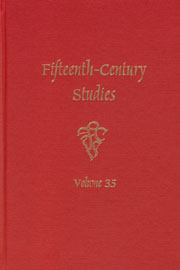Book contents
- Frontmatter
- Contents
- Preface
- Essays
- 1 Violencia en tres cuentos hagiográficos de la España medieval
- Physical Impairment in the First Surgical Handbooks Printed in Germany
- Serious Elements in Medieval French Farces: A New Dimension
- Narrative Afterlife and the Treatment of Time in Henryson's Testament of Cresseid
- Euclid in Boethius's De Consolatione Philosophiae and Some of its English Translations
- Seeking the Medieval in Shakespeare: The Order of the Garter and the Topos of Derisive Chivalry
- A Revelation of Purgatory and Chaucer's Prioress
- Eyeglasses for the Blind: Redundant Therapies in Meschinot and Villon
- Jean de Meun in the Cité des Dames: Author versus Authority
- The Festival Context of Villon's Pet au Deable: Martinmas in Late-Medieval Paris
Eyeglasses for the Blind: Redundant Therapies in Meschinot and Villon
from Essays
Published online by Cambridge University Press: 12 September 2012
- Frontmatter
- Contents
- Preface
- Essays
- 1 Violencia en tres cuentos hagiográficos de la España medieval
- Physical Impairment in the First Surgical Handbooks Printed in Germany
- Serious Elements in Medieval French Farces: A New Dimension
- Narrative Afterlife and the Treatment of Time in Henryson's Testament of Cresseid
- Euclid in Boethius's De Consolatione Philosophiae and Some of its English Translations
- Seeking the Medieval in Shakespeare: The Order of the Garter and the Topos of Derisive Chivalry
- A Revelation of Purgatory and Chaucer's Prioress
- Eyeglasses for the Blind: Redundant Therapies in Meschinot and Villon
- Jean de Meun in the Cité des Dames: Author versus Authority
- The Festival Context of Villon's Pet au Deable: Martinmas in Late-Medieval Paris
Summary
Of the late medieval inventions dating from the period Jean Gimpel has termed the “industrial revolution of the Middle Ages,” none save the printing press had a greater impact on the culture of reading and book production than did eyeglasses: these magnifying devices, invented in northern Italy at the close of the thirteenth century, facilitated the activities of readers, authors, copyists, and illustrators. Though their use quickly spread throughout Western Europe in the fourteenth century, it is in the mid-fifteenth century that French vernacular poets first grant eyeglasses serious literary attention. The two best-known French literary references to glasses, both dating from the early 1460s, appear in Jean Meschinot's Lunettes des Princes and in a brief passage within François Villon's Grand Testament. These two strikingly similar allusions reveal that in the late Middle Ages eyeglasses bear a significant conceptual kinship to books, and, perhaps less intuitively for the modern reader, to the cemetery. For the cemetery figures prominently in late medieval urban life as a didactic space where epitaph and image meet, becoming a memento mori in three dimensions; glasses can therefore constitute a tool with which to “read” the textual and pictorial message. Villon's mock legacy and Meschinot's didactic treatise, however, employ the figure of eyeglasses in conjunction with the textual spaces of the book and the burial grounds in a remarkably self-reflexive fashion. We shall demonstrate that beyond their evident association with visual impairment, literary “glasses” effectively serve to crystallize the emerging primacy of the author at the close of the French Middle Ages.
- Type
- Chapter
- Information
- Fifteenth-Century Studies , pp. 112 - 131Publisher: Boydell & BrewerPrint publication year: 2009



